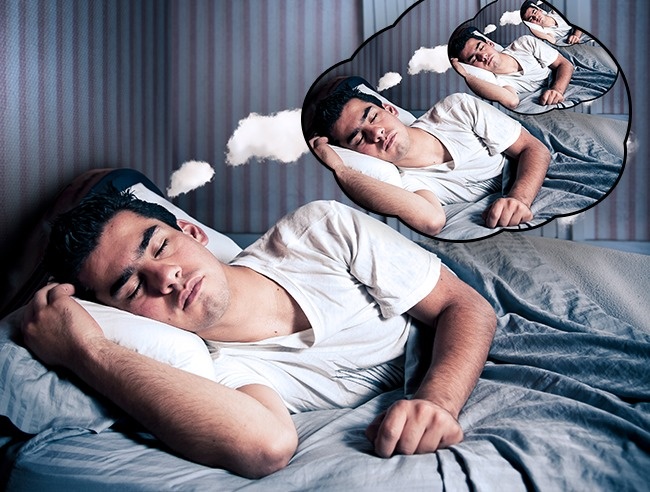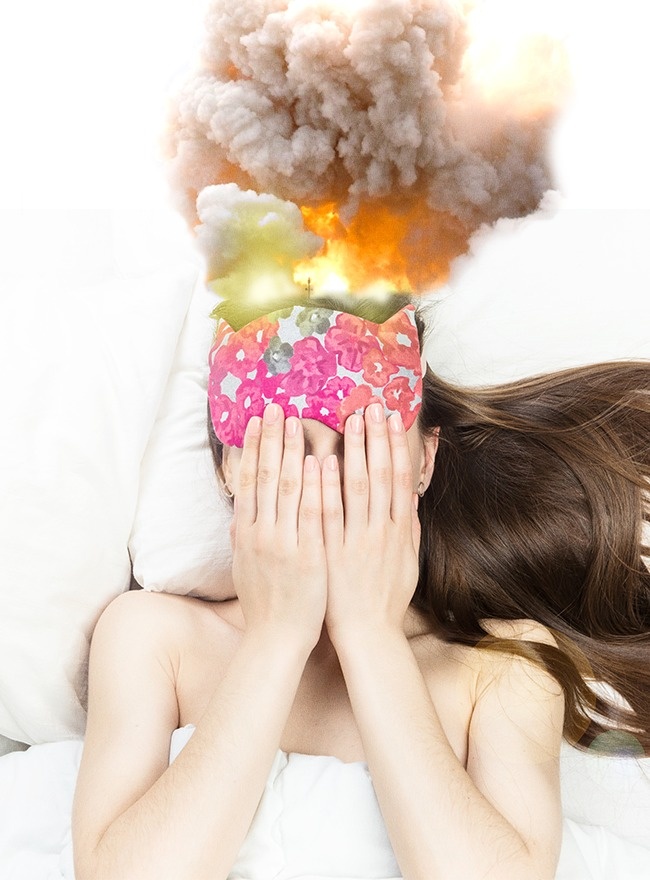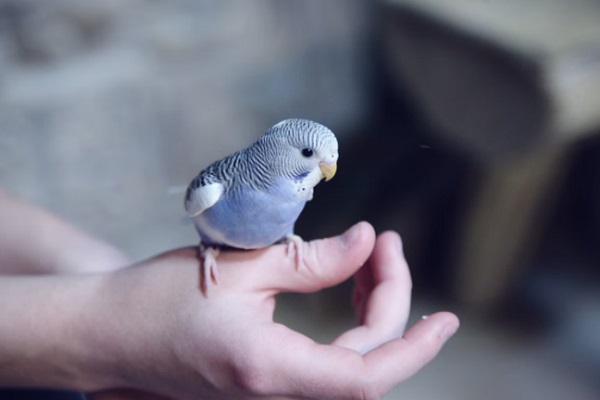For most people, the word “sleep” is synonymous with calm and relaxation after a long day. In fact, in this unconscious mode, the body undergoes a ton of changes. It meticulously gets rid of the damage it has received and prepares for the new day, constantly sorting, restoring, and renewing. So every time you wake up “as a different person,” think about how close to the truth this expression is.
1. Storing and sorting memories

People are restless creatures. We are constantly going somewhere, doing something and communicating with someone, while simultaneously putting aside memories. But a file is useless if it cannot be found. All users of a computer with a cluttered desktop know this.
During sleep, the brain reproduces, catalogs, and stores events, discarding all unnecessary ones. The preservation of long-term memories plays a decisive role in a person’s ability to function normally. Long-term memory is essentially unlimited, so bright moments will likely stay with you for many years.
Sometimes we remember childhood scenes more easily than events from the previous week. These are tricks of the memory, which is responsible for learning and preserving the most useful information. Its main activity occurs during the deep phase of slow-wave sleep, which is comparable to the state of daytime brain activity. At the moment when consciousness passes into rest, the brain turns on the stabilization mode of the most important life memories in order to quickly recreate them if necessary.
2. Lowering temperature and blood pressure

Half an hour before sleep, the body lowers its body temperature. This is done to reduce the rate of metabolism in order to avoid the feeling of hunger at night. As a result, the heartbeat slows down and blood pressure decreases. The temperature also decreases to 35.6 degrees Celsius, which is only 1 degree away from hypothermia. There is no chance of freezing during sleep, since the body needs less energy.
After waking up, blood pressure and heart rate are restored at an accelerated rate to match the level of energy expended. However, a short-term imbalance occurs, which leads to foggy thinking and inertia - typical symptoms after waking up.
3. Paralysis

Remember those nightmares where you can't run, scream, or move? Well, this phenomenon ("sleep paralysis") is terrifying, but quite natural. During sleep, the brain blocks neurotransmitters and muscle receptors, effectively paralyzing the entire body. Sometimes this happens when falling asleep or waking up, when consciousness is clear, but there is no way to move.
Because of its creepiness, this condition has become the basis for many myths and legends inextricably linked to hallucinations. In them, immobilized people are visited by demons or similar mythical monsters (from characters of Anglo-Saxon legends to creatures from Chinese folklore).
4. Stretching

During the day, due to gravity and compression of the vertebrae, the spine is under pressure. Because of this, the fluid from the spinal disc shifts, and the height decreases by about 1 cm in the evening. And when the back is in a lying position, the fluid returns, again increasing the height by the same amount.
Although the difference of 1 cm is not great, the release of the load also allows growth during sleep. In fact, growth is only possible during sleep. This is due to both the removal of spinal pressure and the predominantly nocturnal production of growth hormones.
5. Sleepwalking

Not everyone suffers from it, but almost one-third of the population has experienced it at least once in their life. Technically, sleepwalking is a sleep disorder in which the brain, in a state bordering on unconsciousness, performs difficult tasks such as getting out of bed, going to the kitchen, and even driving.
Sleepwalking is a disturbing phenomenon, but it is quite common, especially among children. Friends, parents, and roommates of sleepwalkers report that they appear dazed and confused while performing bizarre activities (such as cooking), only after which they are able to return to bed.
Scientists are still unsure exactly why people sleepwalk. Some experiments have suggested that genetics may be to blame. Sleepwalking often occurs during slow wave sleep, when the brain processes memories from the day.
This may explain the short-term memory deficiencies of sleepwalkers. When they wake up in the morning, they cannot remember a single minute of their nighttime adventures.
6. Spasms

When we fall asleep, the body twitches. Every time. As mentioned above, during sleep the body is often paralyzed so that during dreams we do not move in reality. But there is one moment when we are neither asleep nor awake.
It's a kind of hypnotic sleep. It's thought to be a delay in sending the "relax" signal from the brain to the nervous system. How exactly it works is not fully understood. Some scientists believe it's a holdover from a primitive reflex that misinterprets falling asleep as suddenly landing from a tree.
Whatever the cause, hypnotic sleep is another evidence of complex unconscious processes. We experience them while actually being awake. Sometimes it can be so strong that it leads to awakening.
7. The brain uses more energy

The bulk of the energy produced during wakefulness (approximately 80%) is used for physical activity, breathing, and speaking. During sleep, these activities are not performed, so the excess energy is sent straight to the brain.
This means that the brain consumes even more energy at certain stages of sleep than during daytime activity. Sleep is the brain's full-fledged time, a kind of leisure, during which it puts in order the processes that allow it to perform energy-consuming tasks and make complex decisions during the day.
8. We lose weight in our sleep

Have you ever woken up from sleep with a terrible thirst? The reason for this is the evaporation of about 0.5 liters of water during the night. The air inside the lungs is quite warm (about 36.7 degrees Celsius) and humid. The average room temperature is below 36.7 degrees Celsius, so the inhaled cold airflow contracts the lungs and draws moisture from the body. During one breath, about 0.02 grams of water is lost. During the whole night, about half a liter is released.
Carbon has a similar but not as strong effect. Everyone knows that we inhale oxygen (2 atoms) and exhale carbon dioxide (3 atoms). When during breathing one atom more comes out than comes in, the mass decreases.
As a result, about 0.7 kg of mass disappears during each night's rest. The same processes take place during the day, but carbon and moisture are replenished with drinks and food.
9. Brain Cleansing

While you are awake, toxins and other waste are stored in the cells of your body and brain. When you sleep, your body shuts down and your brain kicks into action. Essentially, it opens a valve that allows cerebrospinal fluid to flow from your spinal cord to your brain to cleanse your body and detoxify toxic waste.
This process is part of a more complex cycle. This cycle is called cellular respiration. It is a series of reactions that improves the ability of cells to recreate energy from food and maintain the functionality of the body as a whole. The toxins eliminated during sleep are a residual effect of this process.
Although this cleansing affects the entire body, its effects are most visible in the brain, where the effects of inadequate sleep are noted. Brain clutter is one of the main reasons for a bad mood after a long and healthy sleep.
10. Dreams

It is impossible not to mention dreams, which are an integral part of every person's life. But scientists even now cannot really explain this phenomenon. So the question "Why do we dream" still remains unanswered.
If you try to remember the plots of dreams, they will seem seriously implausible. Every night the brain forms an imaginary world that is only within the head, but we perceive it as quite real. After waking up, almost all traces of this imaginary reality disappear. It will sound strange, but dreams are perceived as a given, comparable to brushing your teeth or going to work.
Although the true meaning of dreams is still a mystery, the processes associated with them are still clear: strengthening long-term memory, eliminating brain toxins, increasing activity properties, etc.
But this question is not new. The true purpose of dreams has been a subject of human obsession for many millennia, as the works of the ancient Greeks and Egyptians prove. Despite the existing progress and technical equipment, theories about the origin of this mysterious phenomenon remain theories.
11. Sleep paralysis

A person wakes up at night and cannot move. This is accompanied by frightening hallucinations and a feeling that there is a stranger in the room. In ancient times, this condition was associated with the machinations of evil spirits. Normally, when we fall asleep, we are paralyzed so that we do not perform actions in our sleep. With sleep paralysis, our muscles "switch off" when the brain is still or no longer asleep. About 7 % of the population have experienced sleep paralysis at least once (fact). They say that this happens more often when sleeping on your back.
12. Hypnagogic hallucinations

When a person is on the thin line between sleep and wakefulness, he, being conscious, sees uncontrollable images before his eyes. Often these are scary faces and fantastic creatures. This is one of the few types of hallucinations that visit mentally healthy people. Usually children encounter them (fact), and this can be the reason why they do not want to go to sleep. Often such hallucinations occur due to stress and simply in people with a good imagination. They can appear if you go to bed drunk.
13. Sleep Talking

Usually, the person suffering from somniloquy (sleep talking) does not even suspect it. This condition is not at all dangerous psychologically. Unless the person with such a problem worries that he has blurted out something unnecessary. Somniloquy most often occurs in men and children (fact). The reason is the notorious stress. The human psyche tries to resist what he does not agree with in reality.
14. A dream within a dream

A person dreams, then wakes up, but strange things continue to happen to him. It turns out that he simply dreamed that he woke up. The topic of such dreams was raised in the film "Inception". After that, it turned out that many people experienced something similar. Esotericists believe that if you saw such a dream, it indicates your predisposition to spiritual practices. But official science cannot explain why this happens.
15. Somnambulism

This condition is the opposite of sleep paralysis - consciousness is asleep, but there is no muscle paralysis. In their sleep, people can walk, clean, or even leave the house, and this is often very dangerous. In the morning, people do not remember anything. Somnambulism occurs in approximately 4.6–10.3 % of the population, and children are more likely to suffer from it (fact). The cause of sleepwalking is still unknown, as are the methods of treatment.
16. Exploding head syndrome

A person wakes up from the sensation of a loud explosion or bang. Sometimes it seems that the sound was so loud that you can go deaf. It can be accompanied by an increasing hum or flash. The phenomenon is not dangerous, but it causes fear in people, some think that they have had a stroke. For some reason, there is a surge of neural activity in the areas of the brain responsible for processing sound (fact). Sometimes the syndrome manifests itself against the background of insomnia or a change in time zone during long-haul flights.
17. Sleep apnea

Sleep apnea is a sudden cessation of breathing during sleep. The person wakes up. The quality of sleep decreases, the brain experiences oxygen starvation, it becomes difficult to get enough sleep. During an attack, blood pressure jumps, which can cause heart problems. During sleep, the muscles of the pharynx relax, in some people this leads to blockage of the airways. At risk are obese people, smokers, and the elderly. By the way, playing the Australian didgeridoo helps with apnea (fact).
18. Recurring dreams

Strange dreams that constantly reproduce the same plot have probably been dreamed by everyone. Psychologists believe that with the help of such dreams the brain tries to draw our attention to events that we are not aware of. These plots will return until the situation is resolved (fact).
19. Falling into bed

Sometimes it seems to us that we have been thrown from a height into the bed, we shudder and wake up. Sometimes before this we dream that we are flying or stumbling and falling - quite an unpleasant sensation. The state of sleep is somewhat reminiscent of death - the heartbeat and breathing slow down, muscle tone decreases. The brain "gets scared", perceives this as real death and checks whether the person is alive, sending impulses to the muscles.
20. Exit to the astral plane

A neuropsychological phenomenon in which a person, being between sleep and wakefulness, sees himself from the outside. Mystics and occultists consider it as a confirmation of the existence of the soul. The phenomenon is very difficult to study. While scientists know that the illusion of leaving the body really exists, it is not clear how it works and why it occurs. How to deal with it is also not clear yet. Some people even deliberately enter this state in order to expand the boundaries of their cognitive abilities.
21. Sudden insight during sleep

Sometimes we can't find a solution to a problem for a long time, we constantly think about it. And then in a dream the brain itself tells us the answer, the main thing is to remember it. Everyone knows the example of Dmitry Mendeleyev, who was struggling to create a periodic table and once saw it in a dream. A similar story happened to the chemist Kekule - he saw the formula of benzene in a dream. Sometimes our subconscious already knows the answer, although it has not yet reached consciousness. And then, right during sleep, an epiphany comes. What can I say, sometimes a dream presents such pleasant unexpected bonuses.
The Strangest Things That Happen to Some People in Their Sleep
We are used to perceiving sleep as a rest – a precious time when you can take a break from all the hustle and bustle of the world and recharge your body, tired from the day. It is assumed that every morning we should wake up feeling great and in a good mood. However, for some people, a night of sleep can turn into a tragedy, a crime or even death…
During sleepwalking episodes, people are in a semi-conscious state – half of their brain is awake and the other half is asleep. They do not feel pain and are generally unable to evaluate their actions. But they can perform quite complex actions.
Here are 10 of the most outrageous things people do in their sleep, from driving a car to jumping out of a window.
22. Sending email

Researchers at the University of Toledo report a girl who got up in the middle of the night, turned on her computer, and emailed party invitations to her friends. Although only one such case has been reported so far, the phenomenon already has a name: “Zzz-mailing.” The girl fell asleep around 10 p.m. A couple of hours later, she wrote and sent three emails. One said, “Come over tomorrow and clean up this shithole. Dinner and drinks, 4 p.m. Bring wine and caviar only.” Another briefly exclaimed, “What the….”
She had never experienced sleepwalking before and was understandably shocked the next morning when one of her friends called to say he had accepted her invitation. Sleepwalkers often remember little or nothing of what they did in their sleep. Their consciousness is in an altered state, but they are still capable of performing complex actions. Researchers say the "Zzz-mailing" may have been caused by prescription drugs the girl was taking.
23. Jumping out of the window

People with REM disorder often act out their dreams. "Living as if in a dream" usually implies something good, but not in their case. In 2007, a sleeping teenager walked out of a fourth-story window. After falling about 30 feet, he landed on the sidewalk, where he continued sleeping, not noticing anything. The boy did not take any alcohol or drugs.
Comedian Mike Birbiglia (pictured) once jumped out of a second-floor hotel window in his sleep and fell into the lobby. He woke up covered in cuts that required 33 stitches. Birbiglia, who has been diagnosed with REM sleepwalking disorder, admits to having suffered from sleepwalking for years. “I remember thinking, ‘This might be dangerous. I should probably see a doctor…’ And then I thought, ‘Well, maybe I should just have dinner,’” he says.
24. Real "sleeping beauties"

Victims of Kleine-Levin syndrome are often called "real-life sleeping beauties." They can literally sleep their entire lives away. Periods of sleepiness can last a couple of days or even up to 8 months! In the rare moments of wakefulness, their behavior becomes unpredictable - they can cry for no reason, suffer from gluttony and become childish. When they wake up after such a period, their body tries to gradually return to normal, but this is not so easy. They can go for weeks and months without episodes of sleepiness, returning to normal cognitive function. Those with the syndrome undergo treatment, but its symptoms may never go away completely.
25. Driving a car

Ambien (Zolpidem) is a popular sleeping pill that is often used in arrests of drivers. Ambien users can do strange things and always stand out from other drivers who are drunk or high, especially if they violate their dosage. They drive against traffic, crash into lamp posts and ignore the police. In the last 10 years, there have been two cases of sleepwalkers driving into supermarkets. Another case tells of a nurse, dressed in a thin nightgown in sub-zero temperatures, who crashed into another car and then decided to pee in the middle of an intersection. When the police arrived, she started fighting with them. Sleepwalking drivers often have a zombie-like look in their eyes. Very rarely do they remember getting behind the wheel after taking the drug.
26. Ondina's Curse

Liam Derbyshire, 17, (pictured) has Ondina's Curse, which affects around 1 in 30 million people. Ondina's Curse is a disorder where a person stops breathing when they fall asleep. If they do, they can die within an hour. By 2006, there were only 200 known cases worldwide. Patients require a tracheostomy, a tube in the neck to help them breathe. To survive, they must spend their entire lives on a ventilator, which is attached to the tube when they go to sleep. Liam's parents have to constantly monitor him to make sure he doesn't get tired and accidentally fall asleep, especially in the car. Ondina's Curse is so rare that many doctors never see it and may not diagnose it in time.
27. Conquering the heights

Seeing a silhouette on a tower crane at 2 a.m., passersby thought someone was trying to commit suicide. It turned out to be a sleepwalking girl who apparently left her house unnoticed, passed by the construction site security unnoticed, and managed to climb 40 meters in her sleep. All this time, she had no idea that she was a hair's breadth from death. A fireman climbed up to her, but was unable to wake her up, fearing that upon waking up, she would panic, fall, and crash. In the end, the rescue operation took two hours - the girl was lowered down using a hydraulic lift, safe and sound. Later, her parents admitted that she often suffered from sleepwalking.
28. Nightmares

True nightmares are not just “bad dreams,” which are common and happen to almost everyone. Nightmares affect between 1 and 6% of children and less than 1% of adults. They occur during deep sleep, usually beginning in early childhood and disappearing during adolescence. Nightmare episodes may occur days or weeks apart, every night in a row, or repeatedly during the night.
The eyes of such parasomniacs are wide open, their faces are filled with terror and panic, they sweat, their heartbeat quickens. They often scream – at those around them or just into the void, they fight and seem to be trying to escape from something. During episodes, it is impossible to calm them down because they are still asleep.
29. Murder

By 2005, 68 cases of "sleepwalking" murders had been reported. For example, early in the morning of May 23, 1987, 23-year-old Canadian Kenneth Parks got out of bed, got behind the wheel in his sleep, drove more than 20 km and broke into the house of his mother-in-law and father-in-law. There, he strangled his father-in-law until he lost consciousness and stabbed his mother-in-law to death with a kitchen knife, having first stabbed her with a crowbar. What is most surprising is that after this, still in his sleep, he arrived at the police station, covered in blood and panic. The tendons in his arms were cut in half, but he showed no signs of pain. The readings of his electroencephalogram, which is impossible to fake, were atypical even for a parasomniac. As a result, the court concluded that he was sleepwalking throughout the incident and issued an acquittal.
30. Creating masterpieces of art

Lee Hadwin has suffered from sleepwalking since childhood. So it’s no surprise that he now leads a parallel life in his dreams. He began drawing in his sleep at the age of 4, and as a teenager, his simple childhood drawings evolved into something more sophisticated. They call him “Kipasso.” He says he feels strange because he has no interest in art or painting while awake. And he doesn’t remember anything he did in his sleep.
When he’s not sleeping, Lee works as a nurse. He’s also played in a country band and says he’s much more interested in music than in painting. “I just can’t explain where my painting comes from. It’s like a different part of my brain turns on when I’m asleep,” says Hadwin. And like other parasomniacs, he won’t respond if you call him by name while he’s painting.












